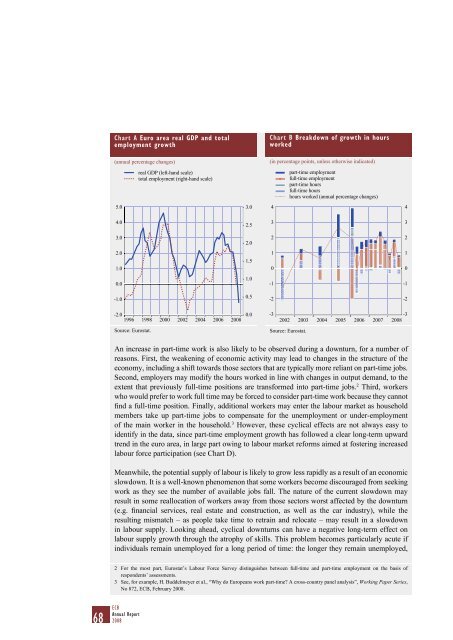ANNUAL REPORT 2008 - Polymer Bank Notes of the World
ANNUAL REPORT 2008 - Polymer Bank Notes of the World
ANNUAL REPORT 2008 - Polymer Bank Notes of the World
You also want an ePaper? Increase the reach of your titles
YUMPU automatically turns print PDFs into web optimized ePapers that Google loves.
Chart A Euro area real GDP and totalemployment growth(annual percentage changes)5.03.04.02.53.02.02.01.51.01.00.0-1.00.5-2.0 0.01996 1998 2000 2002 2004 2006 <strong>2008</strong>Source: Eurostat.real GDP (left-hand scale)total employment (right-hand scale)Chart B Breakdown <strong>of</strong> growth in hoursworked(in percentage points, unless o<strong>the</strong>rwise indicated)43210-1-2-3part-time employmentfull-time employmentpart-time hoursfull-time hourshours worked (annual percentage changes)-32002 2003 2004 2005 2006 2007 <strong>2008</strong>Source: Eurostat.43210-1-2An increase in part-time work is also likely to be observed during a downturn, for a number <strong>of</strong>reasons. First, <strong>the</strong> weakening <strong>of</strong> economic activity may lead to changes in <strong>the</strong> structure <strong>of</strong> <strong>the</strong>economy, including a shift towards those sectors that are typically more reliant on part-time jobs.Second, employers may modify <strong>the</strong> hours worked in line with changes in output demand, to <strong>the</strong>extent that previously full-time positions are transformed into part-time jobs. 2 Third, workerswho would prefer to work full time may be forced to consider part-time work because <strong>the</strong>y cannotfind a full-time position. Finally, additional workers may enter <strong>the</strong> labour market as householdmembers take up part-time jobs to compensate for <strong>the</strong> unemployment or under-employment<strong>of</strong> <strong>the</strong> main worker in <strong>the</strong> household. 3 However, <strong>the</strong>se cyclical effects are not always easy toidentify in <strong>the</strong> data, since part-time employment growth has followed a clear long-term upwardtrend in <strong>the</strong> euro area, in large part owing to labour market reforms aimed at fostering increasedlabour force participation (see Chart D).Meanwhile, <strong>the</strong> potential supply <strong>of</strong> labour is likely to grow less rapidly as a result <strong>of</strong> an economicslowdown. It is a well-known phenomenon that some workers become discouraged from seekingwork as <strong>the</strong>y see <strong>the</strong> number <strong>of</strong> available jobs fall. The nature <strong>of</strong> <strong>the</strong> current slowdown mayresult in some reallocation <strong>of</strong> workers away from those sectors worst affected by <strong>the</strong> downturn(e.g. financial services, real estate and construction, as well as <strong>the</strong> car industry), while <strong>the</strong>resulting mismatch – as people take time to retrain and relocate – may result in a slowdownin labour supply. Looking ahead, cyclical downturns can have a negative long-term effect onlabour supply growth through <strong>the</strong> atrophy <strong>of</strong> skills. This problem becomes particularly acute ifindividuals remain unemployed for a long period <strong>of</strong> time: <strong>the</strong> longer <strong>the</strong>y remain unemployed,2 For <strong>the</strong> most part, Eurostat’s Labour Force Survey distinguishes between full-time and part-time employment on <strong>the</strong> basis <strong>of</strong>respondents’ assessments.3 See, for example, H. Buddelmeyer et al., “Why do Europeans work part-time? A cross-country panel analysis”, Working Paper Series,No 872, ECB, February <strong>2008</strong>.68 ECBAnnual Report<strong>2008</strong>




![KNOW YOUR NEW GIBRALTAR BANKNOTES - [Home] bThe/b](https://img.yumpu.com/50890985/1/184x260/know-your-new-gibraltar-banknotes-home-bthe-b.jpg?quality=85)
![PAPUA NEW GUINEA - [Home] - Polymer Bank Notes of the World](https://img.yumpu.com/49758743/1/190x143/papua-new-guinea-home-polymer-bank-notes-of-the-world.jpg?quality=85)










